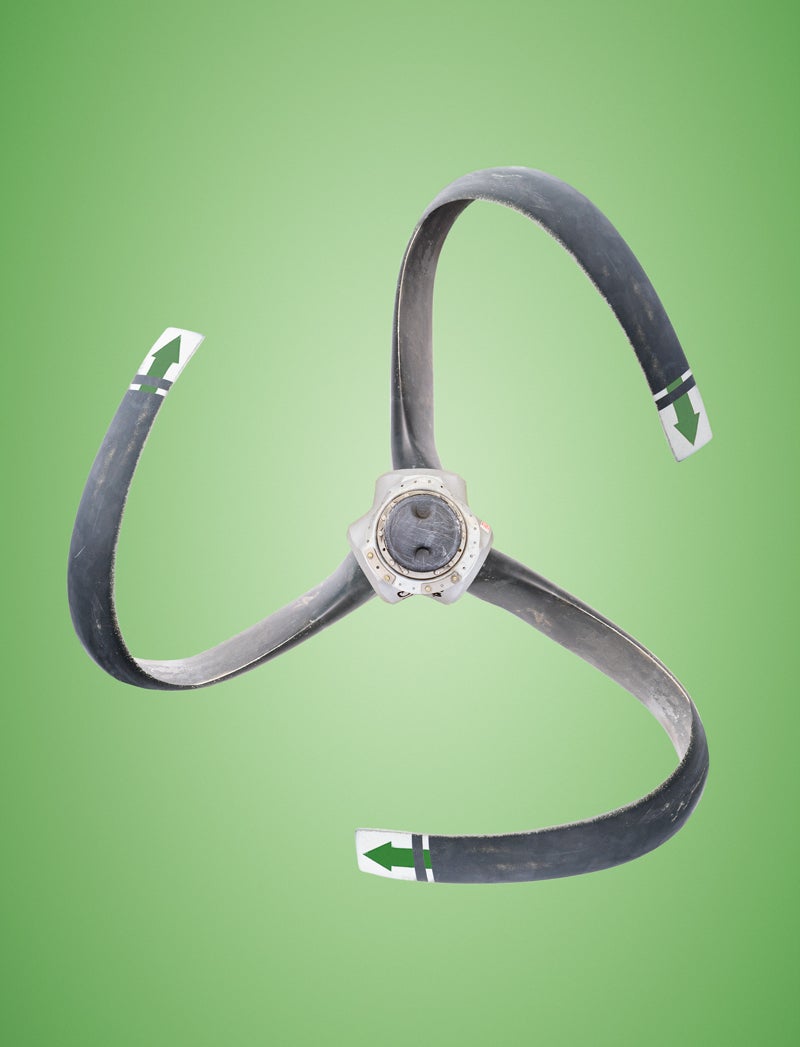How Trash Turns into Treasure in Labs at USC
Waste salvaged from dumpsters, airplane graveyards and more finds a sustainable second life thanks to some creative ideas.
As a chemistry professor, Travis Williams doesn’t usually hang out in alleyways. But that’s where he and fellow scientist Zhiyao Lu PhD ’16 have found themselves on a scorching summer day in Austin, Texas.
Holding their breath, Williams and Lu skirt around a row of bins bulging with chewed chicken wings and wilted French fries. Their guide on this behind-the-scenes tour, a local restaurant owner, points to what they’ve been looking for: a grease-splattered metal container filled with used cooking oil.
“Bingo,” Williams mouths to his colleague.
Trying not to draw unwanted attention — they’re not there to steal anything, and questions would just slow them down — he snaps a few pictures of the grease traps. He is careful to capture the contact information for the company that promises to empty them.
You might ask why two USC researchers care where greasy spoons dump the contents of their deep-fat fryers. The simple answer lies in the power of chemistry. They’re finding ways to transform that waste product into a much-needed renewable fuel — and make the world a cleaner place.
Scientists like Williams and Lu, a postdoctoral scholar in Williams’ research lab at the USC Dornsife College of Letters, Arts and Sciences, are part of a growing group. They’re members of a USC community that uses science to advance environmental sustainability and recycling research. These investigators are giving a second life to byproducts and discarded materials, employing recycling and upcycling to keep waste out of landfills. Oftentimes these processes reduce the need to manufacture materials from scratch, cutting down on greenhouse gas emissions and water pollution. Ultimately, their work has a modest but increasingly important goal: to get the most out of resources with the minimum amount of waste.
FUELING RECYCLING RESEARCH
The world has a trash problem. People toss out more than 2 billion tons of garbage each year, according to a World Bank report. The Environmental Protection Agency reports that the U.S. share of that pile is 262 million tons per year. Paper makes up most of it, followed by food, yard trimmings and plastic.
The recycling of discarded plastic — which can take 1,000 years to decompose — peaked at about 9% in 2018, with the rest diverted to landfills and incinerators or simply left on the ground. That unimpressive figure nose-dived a year ago when China, long the world’s biggest importer of recyclable waste, opted out of the plastics recycling business. It feared being overwhelmed by other countries’ trash. While scientists and policymakers have contemplated creative solutions to disposing of humanity’s garbage, including launching it into space, the down-to-earth solution likely involves creating fewer single-use products and reusing the materials in the goods we do make.
For Williams and Lu, that means giving a new lease on life to the grease in our deep-fat fryers. Before they hit the back alleys of Austin, Williams and Lu had been studying how to upcycle used cooking oil into biofuel at USC’s Loker Hydrocarbon Research Institute. They knew of the potential of biofuels, which burn cleaner than their petroleum-based counterparts and may reduce our dependence on foreign oil, according to the U.S. Energy Information Administration.
One problem is the cost of making biofuel — an issue that has thwarted the biodiesel industry for decades. While soybeans are the biggest source of oils for the industry, the combined energy needed to grow them, extract their oils and use the oils to make biodiesel is too expensive to compete with the petroleum industry. Starting with waste cooking oil reduces the cost, but not enough to make it profitable.
“Unfortunately, the unfavorable economics mean the industry’s expansion has relied on taxes and government subsidies that are designed to drive consumers toward cleaner, more sustainable fuel sources,” Williams says.
So the USC duo searched for ways to make biodiesel turn a profit, and they found it in glycerol.
As Williams explains, the most common way to turn vegetable oil into biodiesel is a chemical reaction that produces glycerol as a byproduct. But glycerol has little use, so it’s cheap. If they’re lucky, biofuel manufacturers can sell it for a few cents per pound to livestock producers, who spray it on the ground to keep dust down. In Southeast Asia, many producers dump it into rivers.
Throwing away glycerol, a “meaty” chemical molecule that boasts three carbon atoms, three oxygen atoms and eight hydrogen atoms, doesn’t sit well with Williams. “As a chemist, I was trained to not waste molecular complexity,” he says. “Glycerol has a lot of molecular complexity, which isn’t reflected by its low price. I knew if we could tap into that value, we’d be able to make biofuel production pay off.”
Williams assigned the chemical puzzle to Lu, who earned his doctorate at USC. Lu returned from industry to the university to focus on pressing environmental problems — like reducing the almost 140 million tons of waste dumped into U.S. landfills each year.
At USC Loker, Lu discovered a way to convert glycerol into something valuable: sodium lactate. Used in the food processing industry, the market for this non-toxic, environmentally friendly chemical is $1.5 billion and growing. Lu patented a catalyst for the reaction, and he and Williams licensed the technology through the USC Stevens Center for Innovation.
They launched Catapower Inc., and their business model earned them the 2018 USC Wrigley Sustainability Prize, which supports environmental ideas from within the USC community that have market potential. That win spurred their successful application to the National Science Foundation Innovation Corps, or I-Corps, an incubator that helps researchers turn their ideas into businesses. Th ey worked on the technology for two months at I-Corps’ Southwest site in Texas.
“In Austin, we were encouraged to talk to real people in our market space and find out if there is a need for our product,” Williams says. “For us, the supply chain begins when restaurant owners discard their used cooking oil, so we started at fast food restaurants.” As a Texas native, Williams knew where to find them.
Williams and Lu got lucky at Fat Sal’s Deli, where the owner took them out back and proudly showed them his new grease trap. After they hopped a few fences, that encounter led the duo to the local dump. That led them to the guy who collects oil from the dump, followed by the guy who filters out the by-now unidentifiable bits of fried food, and, eventually, to the companies that buy the oil and make biofuel. All this trash may become Catapower’s treasure.
The venture aims to open a biofuel plant by 2024. But the technology is already in use at the USC Wrigley Institute for Environmental Studies on Santa Catalina Island. A recycling research demonstration program turns used cooking oil from the center’s cafeteria into biodiesel that powers the institute’s passenger boat.

LIGHTENING THE LOAD
Williams said his approach to research changed when he realized the importance of getting out of the lab and doing chemistry “not on reagents, but on real-world things.”
He aimed for the skies in another project, which gives a second life to the materials used to build light, fast airplanes, like carbon fiber. Increasingly used by commercial aircraft manufacturers like Boeing and Airbus, carbon fiber reinforced polymer composites consist of long woven strands of carbon fibers combined with a matrix, or resin. The material’s structural marriage offers exceptional strength without substantial weight, making the composites popular for airplanes and other vehicles.
Composites account for half of the weight of the world’s best-selling passenger plane, Boeing’s 787 Dreamliner. The carbon composite chassis of BMW’s popular i3 electric car is so light it can easily be lifted by two people. Compared with traditional manufacturing materials — even lightweight metals like aluminum — the weight savings offered by composites make a tangible difference in fuel efficiency.
But there are downsides to composites: their cost, the wasteful manufacturing process and their resistance to traditional recycling. “Planes made of composites are not like their aluminum counterparts, which can essentially be recycled like big soda cans,” Williams says. “Right now, we burn them or bury them, neither of which is good for the environment.”
In 2018, Williams challenged Katelyn Michael ’19, then an undergrad doing research in his lab, with figuring out how to recycle carbon fibers from retired airplanes. Michael, who is now pursuing a doctorate at the University of Wisconsin-Madison, jumped at the chance to tackle a sustainability-related project. The cross-disciplinary research was done with Carlos Navarro, a doctoral student in the lab, and Yijia Ma MS ’17, PhD ’19, who worked in USC Viterbi School of Engineering’s M.C. Gill Composites Center.
“The resin in these composites is chemically engineered. Our thought process was that if these chemicals are purposefully linked together, maybe we can take them apart,” Michael says. “The catalyst we designed specifically targets and breaks the key bond made while curing the material. So, as the resin dissolves away, the woven fibers are left intact and can be collected and reused.” The idea earned Michael and Navarro the 2019 USC Wrigley Sustainability Prize.
Engineer Bo Jin PhD ’17 is another researcher at the M.C. Gill Composites Center working to reclaim composite waste from the commercial aircraft industry. Rather than focusing on scraps from decommissioned planes, though, Jin upcycles composite waste created in the production process. “When you think about the parts in an aircraft, most of the shapes are irregular,” Jin says. “So when you make parts like the fuselage, wings and tail, you end up with a lot of production waste.”
Jin’s recycling research takes advantage of the fact that many composites are manufactured as sheets. Their carbon fibers are treated with a resin but remain flexible until they are cut to size and cured with heat and high pressure. Some estimates suggest that 50-60% of composite sheets end up as scraps on the factory floor at some point in the production line. “I couldn’t believe there was no way to recycle these valuable composites, so when I came to USC, this problem became the focus of my PhD research,” he says.
Today, he continues the work as director of USC’s Advanced Composites Simulation Lab. The process Jin and his team developed involves cutting scraps of composite sheets into thin strips of various shapes and sizes, pressing them in molds and heating them to form new composite parts. It’s a concept he likens to the production of plywood or fiberboard. “Once we’ve formed them, we characterize them internally and externally to measure their strength and stiffness,” Jin says.
While the new sheets won’t be used as major load-bearing structures in airplanes in the near future, the reclaimed composites can be crafted into structures in planes that bear less of a load, like dividers, seats and luggage compartments. They can be used for cars and buildings, too. Jin says his students are constantly striving to expand the applications for their upcycled composites.
Through the students’ creativity, today’s airplanes might take on new life as bicycle frames, skateboards and cellphone cases. Some might be used as oil pipes, or even the grease traps restaurant owners use to dispose of their used cooking oil. “Students join my lab because they are inspired by sustainable innovation,” Jin says. “For them, the possibilities are endless.”



